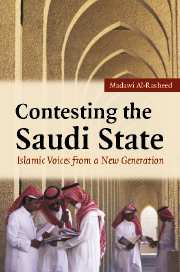|
Reviewed by David Roberts, a Ph.D. candidate at the University of Durham Madawi Al Rasheed pulls no punches as she constructs a detailed and manifestly knowledgeable history of the Saudi State and its inextricable links with the state religion Wahhabism in Contesting the Saudi State. Right out of the gate, she lays out a stark picture of Wahhabism: “Like the political regime it supports and sanctions, Wahhabism is authoritarian. It does not tolerate difference in opinion, and fears any theological debate which may result in questioning either its own monopoly or over religious interpretation or the legitimacy of the political power it supports.” (P.5) This is not to say, however, that it joins the ignominious list of books whose sole purpose is to demonize the Saudi State (i.e. Schwartz’s The Two Faces of Islam) or indeed, those books who seek to absolve the Kingdom and Wahhabism of all wrongdoing (i.e. DeLong Bas’ Wahhabi Islam). Indeed, Al Rasheed judiciously and intelligently wades through the difficulties ever-present when discussing or trying to come to terms with the nebulous nature of Saudi politics. The author begins by analyzing the historical underpinnings and evolution of Wahhabism as stemming from an unquestioned and utterly baseless belief that pre-Wahhabi Arabia was a vile and sordid den of iniquity. Wahhabism, therefore, took the form of a redemptive power, casting away licentious behaviour and resetting the moral compass for the just and saved ones. She continues to explain that there were three means used to consolidate the political realm—the hijra, takfir and the jihad. These refer (respectively) to the demarcation of a Wahhabi-populated promised land, the expulsion of those not sufficiently pious and struggle in all its forms. As often is the case with most discussions of Saudi Arabia, it is the political-religious links that are the most fascinating aspect of the book. The complex interrelationship is very well dealt with by Al Rasheed who documents how Muhammad ibn ‘Abd al-Wahhab an-Najdi and the Al Sauds struck up a relationship of mutual need, dependency, and practicality. The former provided the religious sanctification necessary and the latter provided the practical base from which to proselytize. The split between two is clear and stark. The Wahhabis rule social matters and the Al Sauds the political. This divide has become increasingly deep throughout their history. Yet, there is an interesting see-saw of relative power here. When the Al Sauds need sanctification for something that might not be strictly in line with the tenets of the religion, the Wahhabis demand a higher price. Thus, with the acceptance of foreign (even Christian) help throughout history (e.g. The overcoming of the Ikhwan or agreement for the stationing in the Kingdom of US troops pre-Gulf War) meant larger portions of the social sphere were given over to the Wahhabis for highly public shows of piety. Al Rasheed sensibly recognises 1979 for the seismic year that it was. Faced by a younger, revolutionary and buoyant Iran, Saudi Arabia thus flung itself whole heartedly into the year’s other great event—the Afghan invasion. This offered the Kingdom a golden opportunity to uphold and expand its reputation as a fighter for the Islamic cause, something that had suffered yet further damage with Juhayman ibn Muhammad ibn Sayf al-Otaibi’s seizure of the mosque in Mecca in the very same year. She continues the discussion to show how the celebrated, supported vanguard of Saudi Islamic youth in the early Eighties, became the unwanted, dangerous and evolving threat of the Nineties. The returning Saudi Diaspora engaged in a series of terror attacks in the Kingdom and abroad, which prompted an internal dialogue of sorts into Saudi Arabia’s tacit acceptance and support of the violent strains of the Wahhabi movement. This is, as has been described, an excellent study of the Saudi Jekyll and Hyde. This author has no desire to root through the book again searching for some small snippet to complain about for this book manages to cut through the matter with even-handed and expert ease. It is, far and away, among the best single sources of information on the Saudi-Wahhabi relationship. |


 Contesting the Saudi State
Contesting the Saudi State